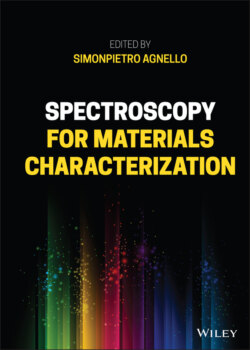Читать книгу Spectroscopy for Materials Characterization - Группа авторов - Страница 28
1.4.1.1 Scanning Device (Bandwidth and Scanning Speed Effects)
ОглавлениеIn a scanning spectrophotometer, the wavelength is selected before to send the light to the sample. As a consequence, it is necessary to take into consideration the time to select the wavelength and correctly connect it to the time necessary to record the signal passing through the sample by the detector. The latter is typically determined by the detector response time (RT). The time to select the wavelength is the scanning speed (SS) of the spectrophotometer. Both parameters can be adapted by the user, in particular larger response time typically warrants a high signal‐to‐noise ratio and a good analysis of the results. Considering that a monochromator selects a wavelength with a range around it, called bandwidth (BW), and that the BW determines the spectral resolution, it is a good practice to use a BW lower than the spectral width of the band (or bands) that is recorded. This spectral width can be experimentally measured by the full width at half maximum (FWHM), that is the spectral distance of the points at half amplitude of the band’s signal maximum. It is opportune to set at least BW < 0.5 FWHM to avoid distortions. After this choice has been done, it is opportune to set RT < BW/SS to avoid other distortions. Indeed, this choice ensures that the time needed for the detector to record a signal is lower than the time necessary for the instrument to change the wavelength in an interval equal to its spectral resolution.
To show the effects that could be produced by a wrong choice of the instrumental parameters, a holmium glass filter has been employed [26, 27]. This sample is characterized by a series of narrow, well‐defined peaks in the spectral range from the visible to the UV; is commercially available; and can be used for teaching‐calibrating purposes. The spectrophotometer used enables to change the BW in the range 0.1–5 nm. Furthermore, it has SS in the range 10–1000 nm min−1 and RT in the interval 0.03–240 s. After an explorative spectrum, the band of the holmium filter centered at about 360 nm has been selected. The SS has been fixed to 20 nm min−1 and the RT to 0.25 s. The first experiment consists in changing the BW.
As reported in Figure 1.8, the different BWs give rise to spectral distortion evidencing that an inaccurate choice compromises the interpretation of the experimental result. In particular, larger BW widens the spectral shape. As reported in the inset of the figure, the effect of distortion can be quantitatively determined by measuring the FWHM. A linear dependence of the FWHM is found on the BW for large values of the latter, whereas for small BW the true width of the band is measured. In particular, the condition BW = 0.4 FWHM somehow guarantees a good estimation of the true width of the band.
Figure 1.8 Top: Absorption spectra of holmium glass filter at various bandwidths of the spectrophotometer from 0.1 to 5 nm. The inset reports the dependence of the full width at half maximum on the various employed bandwidths. Bottom: Absorption spectra of holmium glass filter at various scan speeds of the spectrophotometer from 10 to 1000 nm min−1. The inset reports the dependence of the full width at half maximum on the various employed scan speeds.
In the second experiment, the SS has been changed, fixing the BW = 0.5 nm and the RT = 1 s. As reported in Figure 1.8, the fast scanning of the spectrum induces a strong distortion because of the delay in the response of the detector with respect to the change in the wavelength. These examples show that the instrumental parameters should be opportunely set in order to avoid distortion and at the same time guarantee a good signal‐to‐noise ratio to enable a good analysis of the results.
As a further case, the absorption spectrum of a high‐purity fused quartz glass of commercial origin (Infrasil 301, by Hereaus [28]) is shown in Figure 1.9 with the optimized instrumental parameters BW = 2 nm, RT = 4 s, and SS = 10 nm min−1. The spectrum is reported as a function of energy to clarify those physical features not correctly described by the wavelength, like the spectral shape. Furthermore, the absorption coefficient is reported taking into account the thickness of the experimental sample. It is possible to observe that the used glass features an absorption band peaked at about 5.14 eV superimposed to a larger absorption at higher energy. The lower energy peak is associated to an electronic transition and it is of interest for the determination of the radiative relaxation linked to the photoluminescence presented in Section 1.4.2.1.
Figure 1.9 Absorption spectrum of a commercial fused quartz glass featuring an absorption band in the UV range.
